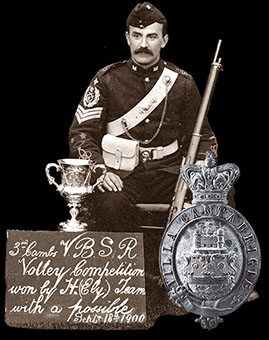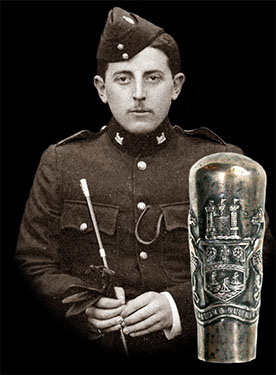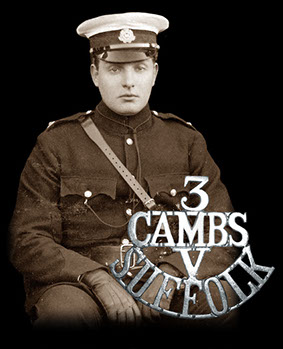
The Cambs
at War
Who Were
The Cambs
1/1st Btn 1914-1919
1914 - 1/1st Overview
1915 - 1/1st Overview
1915 - St Eloi
1915 - Fosse Wood
1916 - 1/1st Overview
1916 - The Schwaben
1916 - St Pierre Divion
1917 - 1/1st Overview
1917 - St Julien
Insignia, Medals & Books
Remembering The Cambs
Biographies
About Us &
This Site

A member of the 1906 Ely Coy shooting team.

A young 2nd Lt Goodwyn Archer later Lt Col.

2nd Lt Cutlack of the Ely Company.
Origins of The Cambridgeshire Regiment TF.
The Regular Army
The first regiment to carry the name of the county of Cambridgeshire was the 30th of Foot. Its formation can be dated back to 1702, but it was not until 1782 that the association with the county was made. This came about when the way regiments were named changed and resulted in many of the numbered regiments being associated with counties. The 30th (Cambridgeshire) Regiment of Foot was born.
The Regiment's 2nd Battalion fought with great distinction during the Peninsula Campaign of the Napoleonic War from 1808. During the battle of Salamanca in 1812 Ensign Pratt of the 30th Foot captured the French Imperial Eagle of the 22 Regiment de la Ligne, a trophy still held with pride by the Regiment's current successors. In 1815 the battalion was once again in the thick of things. Having already spent several days fighting and skirmishing whilst on the march they stood as part of Wellington's army at Waterloo on 18th June 1815.
The years that followed were spent with service in India and home service in the UK. By the time of the Crimean War there was only one active battalion, it served in the Crimean from 1853 to 1856 and fought at many of the now infamous battles at places such as Alma and Sevastopol.
In 1881 after further service in Canada, Ireland and India another restructuring of the Army meant that the 30th Foot was merged with the 59th Foot to form the East Lancashire Regiment. All battle honours were transferred over and the link with Cambridgeshire was lost.
The Militia
While the Regular Army was involved in various campaigns and garrison duties all over the Empire a movement was evolving and growing across the UK. It built on the old idea of locally raised militias, a body of men who after training could return to civilian jobs. They would then attend annual training and be paid a small retainer and could be called up at times of national emergency.
The Cambridgeshire Militia Regiment was raised in 1759. At times of unrest and threat to the nation they served across the country and in Ireland. In 1881 the Government brought about changes in the Army, which included a restructuring and reorganisation of the militias. The local militia regiments were to now be linked with the regular regiments by name and became their 3rd and 4th Battalions. As there was no longer a Regular Army link to Cambridgeshire after the amalgamation of the 30th Foot, the Militia was transferred to the Suffolk Regiment as its 4th Battalion. It was finally disbanded in the 1908 Haldane Reforms.
The Volunteer Force
In 1860 alongside the well established Militia a Volunteer Force of "non professional citizen soldiers" was being formed across the country. The 1st Cambridgeshire Rifle Volunteer Corps was created with companies at major towns across the county, some being formed from the various Rifle Clubs and the Cambs University Corps. After various changes in structure and name in 1887 the 1st Cambs RV Corps became the 3rd (Cambridgeshire) Volunteer Battalion Suffolk Regiment.
The 3rd Cambs VB like its predecessor had its Companies spread out across the county and even included one over the county border at Saffron Walden. Over the next several decades changes were brought in that saw a more uniformed approach to equipment, clothing and training.
Unlike the Militia and the Regular Army, men of the VB were unpaid and had not spent time training with the professional regulars. They had weekly drill nights and annual camps. Although often hard going with training, the camps did offer the chance to travel across the country and escape the riggers of everyday life and work. The focus of training amongst the VB was on drill and shooting and not the tactics and methods of modern warfare.
During the Second Boer War a call went out for volunteers to go over with the Regular Army units. Over 40 men from the 3rd Cambs VB answered the call and went out as part of the Volunteer Service Company of the Suffolk Regiment. They saw service with the regulars and further cemented the bonds between the "part timers" of Cambridgeshire and the regular soldiers of the Suffolk Regiment.
Many traditions and concepts were born in the 3rd Cambs VB that were transferred down to their successor: The Cambridgeshire Regiment TF. Numerous families had fathers and sons serving and it soon became a family tradition for many, this was the same for both officers and other ranks. It also grew in tradition amongst various places of work such as the University Press where volunteers from their work force nearly formed an entire Company.
In 1908 a further widespread restructuring of the Army took place. This resulted in the disbandment of many of the Volunteer Battalions, the 3rd Cambs VB was one of them. However it was to be replaced by a new force that looked to expand on the idea of the VB and modernise them in both formation and training. The Territorial Force was born and with this change the 3rd Cambs VB became initially the Cambridgeshire Battalion, The Suffolk Regiment TF, and then finally some months later in early 1909 the 1st Battalion, The Cambridgeshire Regiment TF.

This site went live on the 14th February 2015 to mark 100 years since the 1/1st Cambs went off to war.
WE WILL REMEMBER THEM
Email us: cambsregt@gmail.com
Copyright 2015, 2016, 2017, 2018, 2019 by Felix Jackson. The information and images on this site should not be reproduced without prior permission.
